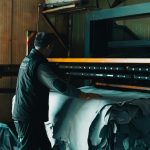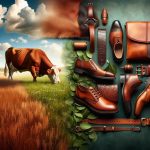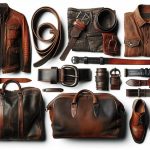Leather is basically tanned animal skin, mainly from cows. It's super durable and flexible, which makes it perfect for a bunch of stuff like jackets, boots, and sofas. The process involves treating the skins with chemicals to preserve them, which turns them into usable leather. There are a few different kinds, like full-grain, which is the top-notch stuff, or split leather, which is more affordable. Producing leather takes quite a bit of resources and has some environmental impacts due to the chemicals used. There's a lot more to learn about how leather is used and how it's made.
Table of Contents
Key Takeaways
- Leather is a durable and flexible material made from animal skins through tanning.
- It comes in various types including full-grain, top-grain, and faux leather.
- Natural leather is derived from animal hides, primarily from cows, goats, and sheep.
- Faux leather, an alternative, is made from synthetic materials like plastic.
- Leather is used in numerous products such as clothing, furniture, and accessories.
Defining Leather Material
Leather is a durable and water-resistant material made from the tanned skin of animals. It's not just any fabric; it's a sought-after material for its robustness and ability to handle wear and tear. When I think about leather, the first thing that comes to mind is its use in high-quality apparel and accessories. It's everywhere, from jackets to boots, and for good reason.
Now, leather isn't a one-type-fits-all kind of material. There are several types of leather, each with its own characteristics. Top-grain leather, for instance, is one of the highest quality leathers you can find. It has a refined finish that not only looks great but also resists moisture pretty well. This makes it perfect for everyday items that might get a bit of exposure to the elements.
For those who prefer not to use animal products or are looking for a more budget-friendly option, there's imitation leather. This material mimics the look and feel of real leather without using actual animal skin. It's made from synthetic materials like PVC, offering a practical alternative while maintaining a similar aesthetic. Whether it's genuine or imitation, leather adds a touch of luxury and practicality to any piece of apparel.
Historical Overview
I've always been fascinated by how leather, one of humanity's earliest and most enduring materials, has evolved over the centuries. This tanned animal skin, known for its robustness and water resistance, has a rich history woven into the fabric of civilizations across the globe.
Here's why leather's journey is so gripping:
- Ancient Beginnings: The crafting of leather dates back to at least 5000 BC, marking it as one of our first achievements in material production.
- Egyptian Innovation: Around 400 BC, Egyptians enhanced leather production by using vegetable-derived tannins for tanning methods, a significant leap forward.
- Renaissance Flourish: During this period, Italy became renowned for its exquisite leathercraft, making Italian leather a symbol of luxury and craftsmanship.
- Industrial Revolution: This era transformed leather production with the introduction of automated machines, enabling mass production and broadening leather's accessibility.
- Durability and Utility: The inherent durability and functionality of leather have cemented its place in both historical and modern societies.
Understanding these milestones helps us appreciate not just leather's utility but also the ingenuity of our ancestors in transforming a simple animal hide into a material that has stood the test of time.
Production Processes
Delving into how leather is made, we start with several crucial stages such as preparation, tanning, crusting, and finishing. In preparation, the hide undergoes soaking, hair removal, and several chemical processes like liming and deliming. This is essential to clean the hide and prepare it for the tanning phase.
Tanning is where the actual transformation happens. Using different tanning methods like vegetable-tanned or chrome-tanned, the hide is treated to become durable and rot-resistant. This stage defines many of the leather characteristics, influencing its final texture, color, and usability.
After tanning, the leather moves to crusting. This stage involves thinning, re-tanning, and lubricating the leather. Sometimes, it includes a coloring process too. Crusting prepares the leather for the final stage: finishing. Here, the leather might be oiled, brushed, polished, embossed, or given a protective coating to enhance its aesthetic and protective qualities.
Throughout these stages, different grades of leather, such as full-grain or top-grain, are made. Each grade affects the leather's quality and price. Understanding these leather production processes helps to appreciate the craftsmanship involved and the value of the finished product.
Types of Leather
Now that we've explored how leather is produced, let's look at the different types available. Understanding these varieties can help you make more informed choices, whether you're buying a jacket, a sofa, or shoes.
- Full-grain leather: This is the cream of the crop when it comes to leather. It includes the entire grain layer, without any removal of the surface. Not only does this make it the most durable, but it also retains the inherent toughness and water-resistance of natural hide.
- Top-grain leather: A bit more refined, top-grain leather has the split layer removed, making it thinner and more pliable than full-grain. It's quite durable but doesn't keep the same level of water-resistance.
- Split leather: Made from the lower layers of the hide after the top is split off, it's less durable and lacks the water-resistance of higher-grade types.
- Nubuck leather: Crafted from the top-grain of the hide but buffed to create a soft, velvety texture. It's durable but requires more care to maintain its texture.
- Faux leather: Made from polyurethane, faux leather is a synthetic material that mimics the look of real leather. It's not as durable but offers a more affordable and ethical choice.
Environmental Impact
Leather production often has a significant environmental impact due to the extensive use of resources and chemicals. Let's break this down simply. First off, the resources. Tons of water and energy go into transforming raw hides into leather. That's a big drain on our planet's resources.
Then, there are the chemicals. During the tanning process, chemicals like chromium and sulfides are used. These aren't your everyday household items; they're heavy-duty chemicals that can be pretty nasty. They help make leather durable and resistant, but there's a downside. These chemicals end up in the wastewater from the factories. Imagine all that polluted water getting into rivers and soils. That's not something we should take lightly.
The pollution doesn't stop at wastewater. The disposal of leather goods poses another environmental challenge. Leather doesn't just vanish into thin air when thrown away; it sticks around for a long time, slowly breaking down and continuing to affect the environment.
To top it all off, the production process releases VOCs—volatile organic compounds. These contribute to air pollution, further complicating the environmental impact of leather production. So, while leather might be stylish and durable, its production and disposal bring along a hefty environmental cost.
Uses and Applications
Many everyday items, from stylish jackets to comfy couches, are made using leather due to its durability and aesthetic appeal. Let's dive deeper into the versatile uses and applications of leather.
Here's a quick snapshot of how widespread leather is in our daily lives:
- Apparel: Leather is a staple in fashion. We're talking jackets, boots, and belts. It's not just about looks; the durability and insulative properties of leather make it ideal for protective gear too.
- Accessories: Ever owned a leather wallet or handbag? Yep, these items not only look great but they also stand the test of time thanks to the robust nature of genuine leather types like top-grain.
- Homewares: Leather furniture, anyone? It adds a touch of elegance and comfort to any room, and let's not forget, it's incredibly long-lasting.
- Automobile Upholstery: The use of leather in car seats combines luxury with durability, making those long drives a lot more comfortable.
- Bookbinding: Leather-bound books aren't only about aesthetic value; they protect the writings with a tough exterior.
Whether it's apparel, accessories, or homewares, leather's applications are as diverse as they're reliable. Its unique blend of aesthetic appeal and functional benefits really sets it apart.
Cost Factors
Understanding the cost factors of leather is essential, as prices can fluctuate greatly depending on various aspects like quality and origin. For instance, top-grain Italian leather is typically pricier than reconstituted Chinese leather. This variation is largely due to differences in quality and manufacturing processes. Top-grain leather, known for its superb finish and durability, undergoes a meticulous process that preserves its natural grains, which justifies its higher cost.
On the other hand, reconstituted leather, which is made from scraps bonded with polyurethane, is more affordable but doesn't offer the same quality or durability. The grade and origin of the leather also play crucial roles in pricing. High-grade leather from renowned origins commands top dollar because it's often associated with better craftsmanship and environmental sustainability practices.
Furthermore, the fact that genuine leather is biodegradable can influence its price. Products that promote environmental sustainability might be priced higher due to their green credentials. Therefore, when you're evaluating the cost of a leather item, it's important to consider these factors to understand why some leather goods are more expensive than others. This insight ensures you're making informed choices based on the type of leather, its origin, and its environmental impact.
Global Production Sites
As we look at global production sites for leather, it's clear that countries like China, India, and Brazil are major players. They don't just lead in quantity, but each has a unique role, especially when we consider the environmental impacts of their industries.
It's crucial to assess how these leather giants manage their production processes and their effects on the planet.
Major Leather Exporters
Throughout the world, countries like Italy, China, India, Brazil, and the United States stand out as major exporters of leather, each known for distinct qualities and styles. These nations not only lead in volume but also in the innovation and quality of leather products they offer. Here's why they're at the top:
- Italy: Celebrated for its artisanal craftsmanship and luxurious leather goods.
- China: Offers a vast array of leather products at competitive prices.
- India: Known for its unique and diverse styles, blending traditional techniques with modern designs.
- Brazil: Famous for its robust, high-quality exotic leathers.
- United States: Provides some of the finest quality leather goods found anywhere in the world.
Each country's contribution elevates the global leather market, delivering quality goods that appeal to various tastes and needs.
Environmental Impact Assessment
Leather production sites around the world have a significant environmental impact, especially in terms of water and chemical waste. The water footprint of these sites is pretty massive because of all the waste water they churn out. Plus, the chemicals used, like chromium, hike up the pollution levels, which isn't great for our planet.
Dealing with solid waste and managing chromium and sulfide in waste water are major issues. Effective pollution control measures are essential to handle these challenges. Also, using enzymes such as proteases in the production process can help minimize the environmental impact by reducing chemical usage. It's crucial to keep pushing for better pollution control to keep our environment safe from the adverse effects of leather production.
Leather Care and Maintenance
When it comes to keeping your leather looking great, knowing how to clean it properly is key. It's also important to store leather items correctly to prevent damage over time.
Let's start by exploring how we can clean and store our leather goods to maximize their lifespan.
Cleaning Leather Properly
To keep your leather items looking their best, start by gently cleaning them with a mild soap and water solution. Leather, made from cured animal skins, requires careful maintenance to prevent drying and cracking. Here are some quick tips to ensure your leather stays in great condition:
- Avoid harsh chemicals that can damage the leather's finish.
- Regularly clean with a soft cloth to remove dirt and oils.
- Moisturize leather with a quality leather conditioner to maintain its suppleness.
- Keep away from direct sunlight and heat to prevent fading and deterioration.
- Test products on a small area before applying widely to ensure they don't harm the surface.
These steps will help maintain and extend the life of your leather goods.
Storing Leather Items
Proper storage is crucial for maintaining the quality of leather items over time. I always make sure to store my leather goods in a cool, dry place away from direct sunlight to prevent them from drying out or discoloring.
I've learned that using plastic bags is a no-go; they trap moisture which can cause mold or mildew. Instead, I opt for breathable fabric or cotton bags that allow for good air circulation.
For leather jackets and coats, I hang them on wide, padded hangers to keep their shape and avoid creases. Also, I make it a point to rotate my leather items periodically. It helps prevent permanent creases and ensures they're evenly aired out.
Leather Certifications
Various certifications are available to ensure that leather products are produced sustainably and ethically. As a consumer who's keen on understanding what goes behind the scenes, it's crucial to know about these certifications. They not only guarantee that you're buying quality but also that you're investing in products that align with your ethical and environmental values.
Here's a brief rundown of some key certifications:
- OEKO-TEX: This certification ensures that leather goods meet stringent sustainable standards, confirming that no harmful substances are used during production.
- Global Recycle Standard (GRS): Focuses on ensuring that leather products labeled as recycled truly meet specific criteria, from the source of the material to the final product.
- USDA and European Commission: It's important to note that these bodies don't certify leather garments as organic. This might affect your choice if you're looking for organic certification.
- Certifications for Ethical Practices: These confirm that the production practices of the leather are ethical, considering both environmental impact and human rights.
- Certified Bonded Leather: This certification is for products using bonded leather, ensuring that they're safe and of a certain standard.
Understanding these certifications helps you make more informed choices, supporting sustainable and ethical production practices in the leather industry.
Frequently Asked Questions
What Material Is Leather?
I've learned that leather is a durable material made from tanned animal hides. It's often used for clothing, bags, and furniture due to its strength and appealing texture.
What Is the Type of Leather?
Leather types vary, including full-grain, top-grain, and Nubuck, each offering unique qualities and uses. I'd say understanding these differences helps anyone master the best applications and care for leather products.
What Is Leather Mainly Made Of?
Leather's primarily crafted from tanned animal hides, including cattle, sheep, and goats. This process transforms the raw skins into durable, versatile material used in various fashion and furniture products.
Can Leather Be Considered a Fabric?
Yes, I'd definitely consider leather a fabric. It's made from tanned animal skins and used similarly to other textiles in clothing, accessories, and furniture, offering both durability and a bit of luxury.







